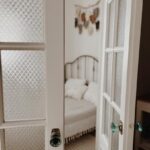Working from home has become increasingly common, making it essential to create a productive and inspiring space. Your home office should be a reflection of your style and personality while also being functional and efficient.
In this article, we will explore the importance of a well-decorated home office and provide tips on how to assess your space, choose the right color scheme, select essential furniture, personalize your workspace, maximize efficiency, find the best lighting solutions, and decorate on a budget.
Creating a well-decorated home office is crucial for maintaining focus, productivity, and overall well-being. The environment in which you work can have a significant impact on your mood and motivation. A thoughtfully decorated space can inspire creativity and encourage efficiency. Whether you have a dedicated room for your home office or just a small nook in your living room, there are various ways to make the most out of your workspace.
In the following sections, we will delve into practical tips for assessing your space, selecting the right color scheme, choosing functional furniture, adding personal touches to personalize your workspace, maximizing efficiency through organization, finding the best lighting solutions, and decorating on a budget. By following these guidelines, you can transform your home office into an inviting and productive environment that reflects your individual style.
Assessing Your Space
When it comes to setting up a home office, one of the first steps is to evaluate the available space and determine the ideal layout for your work area. Whether you have a dedicated room or are working with a small corner in another room, assessing your space is crucial in creating a functional and comfortable home office environment.
Evaluating the Size and Dimensions
Begin by measuring the dimensions of the space you have designated for your home office. Take note of any architectural features such as windows, doors, or alcoves that may impact the layout of your workspace. Consider how much room you need for essential furniture items like a desk, chair, and storage units. By understanding the physical constraints of your space, you can plan a layout that maximizes functionality and efficiency.
Considering Traffic Flow and Accessibility
Think about how you will move within your home office throughout the day. Take into account factors like doorways, walkways, and power outlets when planning where to place furniture and equipment. It’s important to create a workspace that allows for easy movement and access to necessary items without feeling cramped or obstructed.
Creative Use of Small Spaces
If you’re working with limited space, get creative with storage solutions and compact furniture options. Utilize vertical wall space with shelves or wall-mounted organizers to keep items off your work surface. Consider multifunctional furniture pieces that can serve dual purposes, such as a desk with built-in storage or a rolling cart that can be used for both storage and additional workspace. With some thoughtful planning and organization, even small spaces can be transformed into efficient home offices.
By carefully evaluating the size and layout of your home office space, you can set the foundation for an organized and productive work environment. Taking these factors into consideration will help you make informed decisions when selecting furniture, arranging the layout, and optimizing functionality – all essential components of creating an effective workspace.
Choosing the Right Color Scheme
When decorating your home office, choosing the right color scheme is essential to creating a productive and inspiring atmosphere. The colors you choose can have a significant impact on your mood, creativity, and overall well-being while working from home. Here are some tips for selecting the perfect color scheme for your home office:
1. Consider the Purpose of the Space: Think about the primary purpose of your home office. If you need to focus and concentrate, consider using calming and soothing colors like blues or greens. For a more creative environment, vibrant and energizing colors like yellows or oranges can be a great choice.
2. Evaluate Natural Light: Take into account the natural light that enters your home office. If your workspace receives plenty of natural light, you may have more flexibility with darker or bolder colors. However, if natural light is limited, lighter shades can help brighten up the space and make it feel more open and inviting.
3. Coordinate with Your Furniture: Consider the color of your furniture when choosing a color scheme for your home office. You’ll want to ensure that the colors complement each other to create a cohesive look.
By carefully selecting the right color scheme for your home office, you can create an environment that fosters productivity and creativity while also reflecting your personal style.
– Additionally, consider incorporating plants or artwork in coordinating colors to tie everything together.
– Don’t be afraid to experiment with accent walls or pops of color through decor items like throw pillows or desk accessories.
– When in doubt, neutral colors like whites, grays, or beiges can provide a clean canvas for adding splashes of color with decorative elements such as rugs, curtains, or wall art.
– Remember that everyone’s preferences vary so feel free to choose colors that resonate with you personally while still promoting focus and energy in your work environment.
By following these tips on how to decorate my home office with the right color scheme in mind, you can create an atmosphere that enhances both productivity and inspiration in your work space.
Essential Furniture
When it comes to creating a productive and comfortable home office space, selecting the right furniture is essential. Your home office furniture should be functional, comfortable, and conducive to productivity. In this section, we will explore some key considerations for choosing the essential pieces for your home office.
Invest in a Quality Desk and Chair
The cornerstone of any home office is a good desk and chair. When selecting a desk, consider the size of your space and your work needs. Do you need ample surface area for spreading out paperwork, or will a smaller desk suffice? Additionally, choose a chair that provides proper support for your back and promotes good posture to avoid discomfort during long hours of work.
Storage Solutions
Effective storage is vital in maintaining an organized and clutter-free home office. Consider investing in quality shelving units, filing cabinets, or storage ottomans to keep your workspace tidy. Choose furniture pieces that offer both functionality and aesthetic appeal to enhance the overall look of your home office.
Multipurpose Furniture
Maximize the use of your space by considering multipurpose furniture items. For example, a desk with built-in storage or a convertible standing desk can help save space while providing extra functionality. Additionally, consider furniture pieces that can easily transition from work mode to personal use, such as a stylish bookshelf that doubles as a display area for decorative items.
By carefully selecting essential furniture pieces tailored to your specific needs and preferences, you can create a well-equipped home office that supports productivity and comfort without sacrificing style or functionality.
Personalizing Your Space
When it comes to creating a home office, personalizing the space is essential in making it a comfortable and inspiring environment. Adding personal touches and decorative elements can not only enhance the overall aesthetics of the workspace but also reflect your individual style and personality. Here are some tips on how to decorate your home office to make it truly your own:
- Display Personal Mementos: Showcase items that hold sentimental value, such as family photos, travel souvenirs, or awards and certificates. These personal mementos can serve as motivation and remind you of your achievements, while also adding a touch of warmth to the space.
- Introduce Indoor Plants: Incorporating greenery into your home office can bring a sense of nature indoors and contribute to a calming and refreshing atmosphere. Consider placing potted plants or small succulents on your desk or shelves to add a pop of color and life to the space.
- Use Decorative Accessories: Incorporate decorative accessories like stylish desk organizers, unique paperweights, or vibrant artwork that resonates with your interests and passions. These items can not only elevate the visual appeal of your home office but also make it feel more personalized.
By incorporating these personal touches and decorative elements into your home office, you can create a space that is both functional and reflective of your individuality. Whether it’s through sentimental keepsakes, natural elements like plants, or decorative accessories, infusing your workspace with personal touches can significantly impact how you feel while working in this environment.
Organizational Tips
When setting up your home office, it’s essential to prioritize organization to maximize space and efficiency. Clutter and disorganization can lead to decreased productivity and make it challenging to focus on the tasks at hand. Here are some tips on how to decorate my home office while keeping it organized and functional.
First, invest in storage solutions that make the most of your available space. Whether it’s shelves, filing cabinets, or storage bins, having designated places for your documents, supplies, and equipment will help keep your workspace tidy. Consider utilizing vertical storage options to free up valuable desk or floor space.
Another organizational tip is to establish a system for managing paperwork and digital files. Create a filing system that works for you, whether it’s color-coded folders, labeled binders, or digital folders on your computer. Keeping your paperwork organized will not only make it easier to find what you need but also contribute to a more visually appealing office environment.
In addition to physical organization, consider implementing daily habits that contribute to a tidy workspace. Take a few minutes at the end of each workday to clear off your desk, put away any supplies or equipment, and straighten up the area.
This simple routine can set the stage for a productive start to the next workday. Creating an organized home office doesn’t have to be complicated or expensive – with some thoughtful planning and smart storage solutions, you can enjoy a functional and efficient workspace without breaking the bank.
| Organizational Tips | Maximizing Space and Efficiency |
|---|---|
| Invest in storage solutions | Utilize vertical storage options |
| Create a filing system | Establish daily organizational habits |
Lighting Solutions
When it comes to creating a well-lit and inviting workspace in your home office, lighting is key. The right lighting can enhance productivity, reduce eye strain, and contribute to the overall aesthetics of the space. Here’s how to choose the best lighting solutions for your home office.
First and foremost, consider natural light. Position your desk near a window to take advantage of natural light during the day. Natural light is not only beneficial for your health and well-being but also helps create a bright and energetic atmosphere in your home office. If natural light is limited, consider using sheer curtains or blinds that allow sunlight to filter through while reducing glare.
In addition to natural light, it’s essential to have adequate artificial lighting in your home office. A combination of overhead lighting, such as ceiling-mounted or track lights, and task lighting, such as desk lamps or under-cabinet lights, can help illuminate the space effectively. Adjustable task lighting is particularly useful as it allows you to direct light where you need it most, whether you’re reading documents, typing on a keyboard, or working on detailed tasks.
Lastly, consider the color temperature of the bulbs you use in your home office. Cooler color temperatures (measured in Kelvin) are ideal for promoting focus and alertness, while warmer color temperatures can create a more relaxed ambiance. LED bulbs are energy-efficient and come in a variety of color temperatures, making them an excellent choice for home office lighting.
| Lighting Solutions | Benefits |
|---|---|
| Natural Light | Enhances productivity and reduces eye strain |
| Artificial Lighting | Illuminates the space effectively with adjustable options |
| Color Temperature | Affects focus and ambiance; LED bulbs are energy-efficient |
Budget-Friendly Decor
In conclusion, decorating your home office does not have to be a costly endeavor. By following the tips outlined in this article, you can create a productive and inspiring workspace without breaking the bank. Assessing your space, choosing the right color scheme, and selecting essential furniture are all important steps in creating an efficient home office that reflects your personal style.
Personalizing your space with decorative elements and adding organizational touches will not only make your home office visually appealing but also functional. Maximizing space and efficiency while creating a well-lit and inviting workspace is crucial for promoting productivity and creativity. With the right lighting solutions and budget-friendly decor, you can transform your home office into a place where you enjoy spending time working.
In the end, it’s all about finding a balance between aesthetics and functionality when decorating your home office. Remember that a well-decorated space doesn’t have to come with a high price tag. With careful planning and consideration of the tips provided in this article on how to decorate my home office, you can create a stylish and practical workspace that suits both your needs and your budget.

I’m thrilled to be your companion on this exciting journey through the world of home decor and design. With a passion for turning houses into homes and a keen eye for the finer details, I’m here to help you transform your living spaces into beautiful, functional, and meaningful havens.





